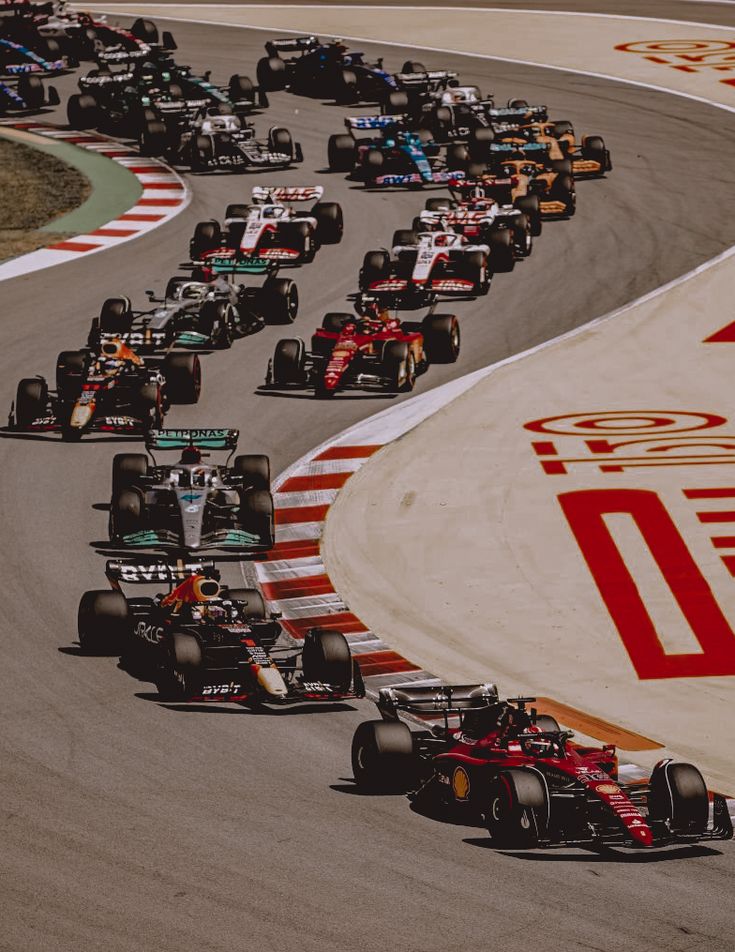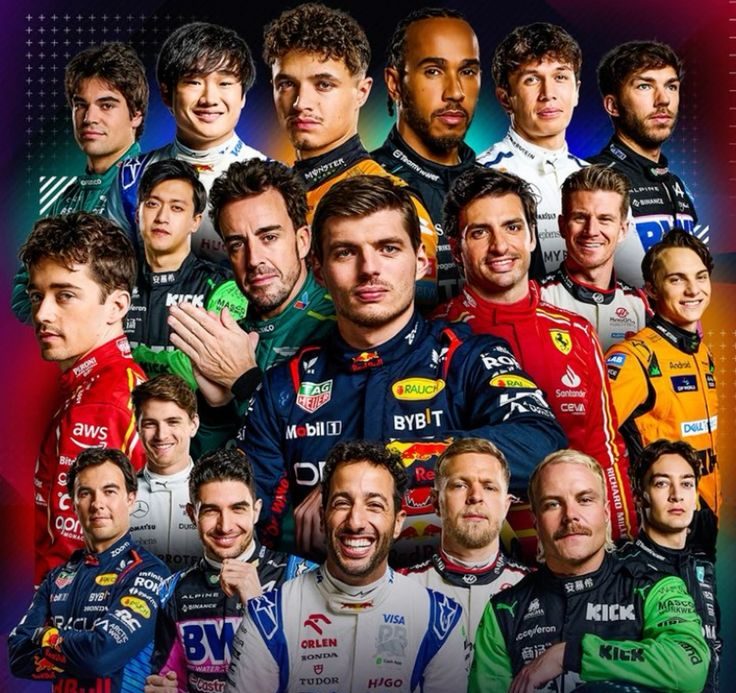Don’t freak out, this is not one of those boring formulas you have to memorize for math, it’s the highest class of car racing in the world. 20 gorgeous men (for now) travel to race tracks in 21 countries across five continents to drive specially designed cars very fast. Like 234 miles per hour fast. With the amount of G forces the drivers experience during a race, they’ve been compared to fighter pilots and even astronauts. Though only one person drives the car, it is ultimately a team sport, with a team president, highly trained mechanics, and race engineers all working together to design and produce the best possible car.
The 10 teams (2 drivers per team) compete for the constructors’ championship between teams, while the individual drivers simultaneously compete for the individual driver’s championship. Each of the 24 races takes place over about 3 days – a racing weekend – which includes free practices on Friday, three-stage qualifiers to determine starting position on Saturday, and the actual race on Sunday. Sometimes there are also sprints, which are 100km races that replace the third free practice on Saturday. These all contribute to earning points towards the championships, and the over $140 million (as of 2023) that the top team receives out of the $900 million pool.
Teams are funded with a combination of private ownership, sponsorships, and commercial agreements, so a win encourages raises from those sources which can supplement the prize money. These huge sums often go towards car improvements for the following season in hopes of maintaining a winning streak. There is huge prestige associated with the competition since drivers represent themselves, their team, and more implicitly, their country.
Though Formula 1 racing has existed for almost a century, it has only recently gained more global popularity and renown, especially in the American market. The sport can be complicated, but with the geopolitical and economic influence it exerts, knowing the key players [or rather the (good looking) drivers] and the rules of the road is of greater importance than merely recreational enjoyment.
Formula 1 racing is interwoven with history. Beginning in earnest in 1950 with the inaugural running of the FIA Formula One World Championship (though the first race with developing Formula 1 rules took place in Turin in 1946), the first championship was won in a season of 6 races, and the Indy 500 by the Alfa Romeo driver. The constructor’s championship was added shortly after, in 1957. Cars began to change in the 60’s as engines were placed in the middle of the cars, behind the driver’s seat, instead of the front, and sponsorships, primarily tobacco, were advertised on the livery. Renault, McLaren, Williams, and Ferrari dominated from 1979-2008, winning every constructors title, and every drivers championship title starting in 1984. Renowned driver Aryton Senna died tragically in 1994 during the San Marino Grand Prix, the day after another driver crashed and died during qualifying, prompting the FIA to begin pursuing serious safety adaptations to meet the advancing automotive technology. These were largely successful as no driver died for 20 years, until Jules Bianchi in the 2014 Japanese Grand Prix. This resulted in the institution of a Virtual Safety Car (VSC – see glossary) as the collision was with a safety car. The FIA has mandated the halo on all of its cars since 2018, and the curved bar above the drivers’ heads has been credited with multiple lives saved. Lewis Hamilton has tied the world record of 7 Drivers Championship titles in recent years, making history. The FIA also instituted a cost cap of $95 million since 2023, with it set to increase to $130 million in 2026, amidst controversy.
The sport has recently risen in popularity, averaging 1.2 million viewers after the first 14 races of the 2024 season, according to ESPN. 2023 averaged 1.1 million viewers and 2022 set a record of 1.21 million average viewers. Many credit the popular Netflix show Drive to Survive with their introduction to Formula 1, like senior Stevie Zonarich, who is one of those 1.2 million, watching almost every race with her sister. Liberty Media acquired Formula 1 in 2017 and has pushed the sport’s marketing, exponentially expanding its fan base. On top of that, shows and movies about motorsport like Ford v. Ferrari (2019) and Gran Turismo (2023) have capitalized on the increase in viewership, with a new movie starring Brad Pitt specifically focusing on F1 set to release in June 2025.
What draws people into the sport? For Dr. Jeremy Wear, a beloved Stone Ridge English teacher who grew up around racing (albeit NASCAR) in small-town Tennessee, it is the combination of technology and talent. “It’s a sport where you can be the most talented person on the track and come in last every time.” Stevie agrees “I think the cars are really cool, […] and it’s up in the air who will win the races […] since now [the competition] is a little more even [with the cost cap].” Dr. Wear got into the sport during the pandemic when his friend group started F1 fantasy teams out of boredom and was surprised to see the extent of that talent. He was amazed by the high physical demands of the sport – drivers lose four to nine pounds per race, burning 1000 calories per hour in the sweltering cockpit experiencing up to 6gs (G forces – 6 times the force of gravity) at times. He also cites the drama of such personal competition as well as the geopolitical tensions. “You sometimes wonder if it’s national rivalries being played out through these cars.”
F1 is truly a global sport as many countries have stake in many aspects of it, and therefore the geopolitics can get complicated. Take Haas, which is technically an American team with an American president (Gene Haas), run by a German (Guenther Steiner), once funded by a Russian company (Uralkali), which then employed the company owner’s son (Nikita Mazepin), but outsources its engine to Ferrari, which is Italian and has its own team. All of that adds up to a lot of competing loyalties. Following Russia’s invasion of Ukraine, the contract between Haas and Uralkali was terminated, leaving the team floundering for funding and a replacement driver. Numerous situations like this continue developing as teams with different national loyalties compete around the world. Questions have been raised if races should continue to be held in the Middle East and China as tensions rise and conditions get more desperate. Sportswashing, which uses sport to legitimize a country or regime, is a major concern and may dictate driver choices and race schedules. “It certainly makes for a more interesting silly season as teams aren’t necessarily going after the best driver they can get, they’re chasing sponsorship money,” comments Dr. Wear. “It definitely adds to [the allure of the sport].”
In 2022, the sport brought in over 2.57 billion dollars as a result of increased viewership, meaning the sport has significant economic influence. By contrast, FIFA, which also has global relevance, made 1.17 billion dollars in 2023 – less than half that of Formula 1. However, it can be hard to reconcile these huge sums with the persistent poverty seen in many of the countries that are hosting the races. “If you look at the amount of money that flows through the sport and what it gets spent on,” says Dr. Wear, “there is part of it that feels unjustifiable.”
The environmental cost of the sport is hefty, too, with the amount of global travel and the emissions of the cars themselves. A report from F1 states that every season, 256,000 tons of carbon dioxide are released into the atmosphere. They have launched a new strategy to combat this since 2019 developing new fuel and increasing use of renewable energy. Dr. Wear points to Drive to Survive as increasing the “scrutiny” on the sport, adding pressure to make a change. The FIA has promised carbon neutrality by 2030.
As the conclusion to the 2024 season quickly approaches with the Abu Dhabi Grand Prix on December 8, the competition for the world drivers championship is neck and neck between Lando Norris and the reigning champion, Max Verstappen. The constructor’s championship is also competitive, primarily between Mclaren, Ferrari, and Red Bull.
The 2025 season marks the sport’s 75th anniversary and it brings significant changes. Lewis Hamilton, winner of a record 8 world championships, will be moving from his home team, Mercedes, to Ferrari, for the cheap, cheap price tag of $400 million. Rookies Liam Lawson and Franco Colapinto have already replaced Daniel Ricciardo and Logan Sargeant during the season, and two more rookies, Oliver Bearman and Kimi Antonelli, will join the grid with Haas and Mercedes, respectively, amid other driver switches and deals. The Grand Prix schedule has been rearranged to accommodate Ramadan as well as to group countries together to reduce the carbon footprint of flying to the 21 countries.
F1 is an entertaining, complex sport that has changed enormously since its foundation. With major economic, geopolitical, and environmental issues at stake, the sport has global relevance and its evolution is something to keep an eye on in the changing landscape.
Comment any remaining questions and I will do my best to answer them!

























John-Marc Clark • Nov 18, 2024 at 11:32 am
Does F1 have any scholarship and other community oriented programs that allocate and invest some of the profits toward improving the living conditions of people in the countries where the races take place? I really found your article informative and insightful! Well done!
Stephanie • Nov 1, 2024 at 12:41 pm
Very interesting article. How do you think the role of women will evolve in Formula One racing?